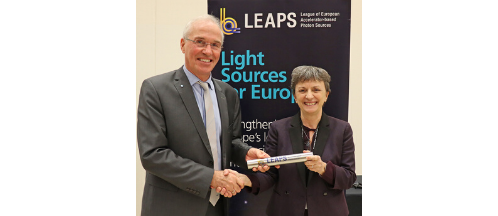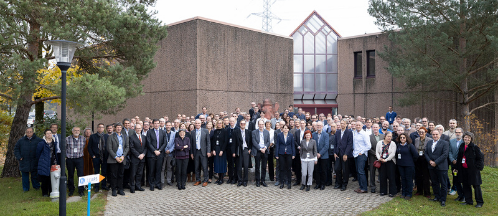

At the left, Helmut Dosch handing over the symbolic baton of LEAPS to Caterina Biscari. At the right, a group photo of the attendees to the second LEAPS Plenary Meeting.
Cerdanyola del Vallés, 2nd December 2019. The second LEAPS Plenary meeting was hosted by the Paul Scherrer Institut in Villigen, Switzerland on 18–19 November. The participants met up to discuss how the LEAPS Programme should be developed to best meet the needs and expectations from scientists using the facilities, from the funders and society at large.
The first day of the Plenary started with a welcome to PSI by Leonid Rivkin, PSI vice director. It continued with an update on the LEAPS status by Ute Krell, DESY, and by Caterina Biscari, ALBA director, the ExPaNDs status by Mark Heron, Diamond Light Source and the PaNOSC status by Andy Goetz, ESRF. Mirjam van Daalen, PSI chaired this first session, and it was summed up in a panel discussion lead by Jean Daillant, Soleil.
The afternoon was devoted to meetings between the different workgroups and strategy groups within LEAPS to discuss future steps, e.g. LEAPS addressing clusters and missions in Horizon Europe, the roadmap process and smart specialisation. All of which was presented by the group leaders in plenum, guided and summed up by Gastón García, deputy director of ALBA and LEAPS Coordination Board vice chair.
The second day, when guests and representatives from national funding agencies and ministries joined the Plenary meeting, started with Thierry Strässle, PSI welcoming the participants and giving a short overview of the facility. Following this, Helmut Dosch, DESY and Caterina Biscari – chair and vice-chair of LEAPS – gave an update on the LEAPS status and outlook to set the stage for the newly arrived.
An essential topic was to explore how to make the most of the national funding by adding funding from Horizon Europe (HE). LEAPS is clearly anchored in HE's Pillar 1, Excellent Science, but also opens up opportunities for so-called co-creation with Pillar 2, Global Challenges. In addition, LEAPS meet the transversal goal in HE, Widening Participation and Strengthening the European Research Area, very well through the educational, training and outreach activities done as well as by granting free access to the facilities based on scientific excellence no matter from which country the research group comes.
LEAPS is currently negotiating a funding scheme with the European Commission, and the ambition is clear: LEAPS should be given the status of a European Partnership within HE. However, as Helmut Dosch, and Caterina Biscari, declared in their opening statements; "LEAPS recognise an inherent added value in this new pan-European cooperation, independent of funds from Brussels. By showing that we have a strong will and ambition to cooperate by implementing joined projects, we will get a powerful voice and a visible place in Europe."
The plenary session that followed, chaired by Andrew Harrison, Diamond Light Source, began with a presentation on Horizon Europe by Adam Tyson, Head of Unit, Research & Industrial Infrastructures, European Commission. Tyson pointed out that it is a moment of change within the EC. Not only by having a new President-elect, new Commissioners, new portfolios and policies, but also change in terms of identifying new challenges and new ways of working. He said that "the new vision and priorities set out by President-elect Ursula von der Leyen are all issues where research and innovation have a strong role to play. It is a fantastic opportunity but also a very big responsibility for all stakeholders in the field."
National and Pan-European strategies need to be aligned with the European strategy to maximise the impact on global challenges. Collaboration is necessary not only between research facilities of the same sort, such as LEAPS but also with other types of research facilities and consortiums to be able to provide fully integrated services to the researchers. Problems must be solved through a more significant integrated approach.
Next speaker was Christian Ruegg from PSI representing LENS, League of European Neutron Sources, who gave an update on their status and following him was Rolf Heuer, Chair of SESAME, who showed the progress of the international synchrotron facility in Jordan, which is associated to LEAPS since 2018.
The theme for this second LEAPS Plenary meeting was "LEAPS benefits all of Europe" and to give a broad view on this topic, a panel discussion lead by Andrew Harrison, DLS, was held. Participating in this was Mirjam van Daalen LEAPS/PSI, Diego Casadei, CosyLab, Michael Hennig, LeadXPro, Edward Mitchell, LEAPS/ESRF, Marco Stampanoni, PSI/GratXray AG, Francine Solal, CNRS, France and Kirsi Lorentz, The Cyprus Institute, Cyprus. The conclusion drawn was that research facilities need to engage with users from both industry and academy to make the most of the investments already done and to have firm and long-term support from national funding agencies and ministries to be able to stay world-leading and produce excellent science.
With these presentations as a background, the workshop session of day two clarified how industry and European member states can contribute to and benefit from LEAPS in the context of HE strategy, as described out by Adam Tyson. It also explored the possibilities for even further cooperation with universities and research centres. All with the purpose to integrate existing and new user communities in not only the use but also the development of research facilities. The result of these workshops was presented in the last session, chaired by Britta Redlich, FELIX, and will be used as input for the continued work that will lead to a comprehensive LEAPS Programme, benefitting all of Europe.
The meeting then went on with a presentation by Gastón García, on achievements and future plans of LEAPS Landscape Analysis. Klaus Attenkofer, scientific director of ALBA, presented the upcoming "LEAPS meets Quantum Technology Conference" in May 2020, and finally, conclusions and next steps were summed up by Helmut Dosch and Caterina Biscari.
Finally, as Caterina Biscari will take over as Chair of LEAPS in January 2020, Helmut Dosch took the opportunity to hand over the symbolic baton of LEAPS during the Plenary meeting and wishing her good luck in the future work. He also thanked all participants for having had the opportunity to lead the accelerator-based European photon sources in their endeavor to shape a world where European science is a catalyst for solving global challenges, a key driver for competitiveness and a compelling force for closer integration and peace through scientific collaboration.




